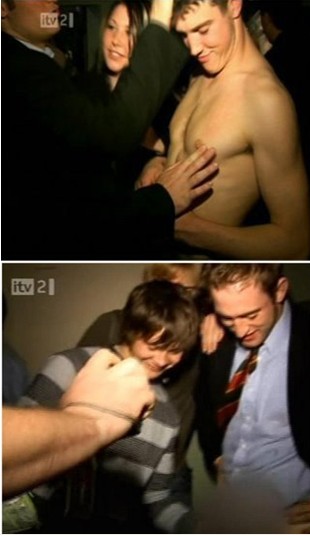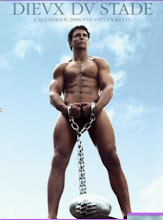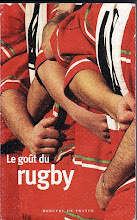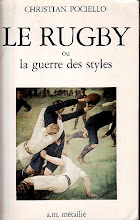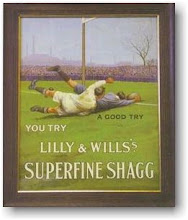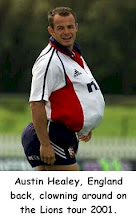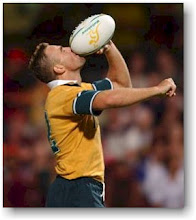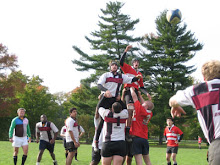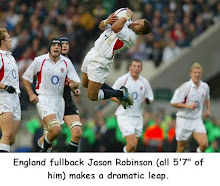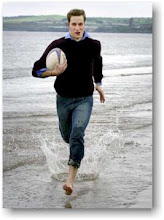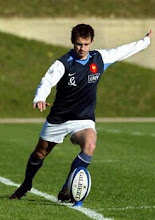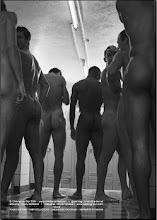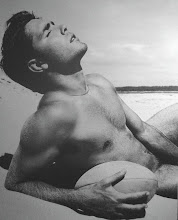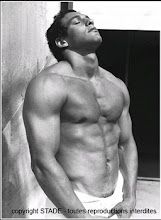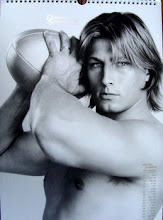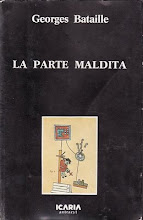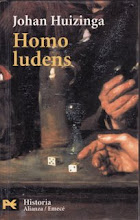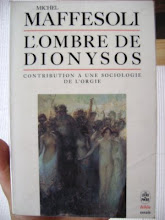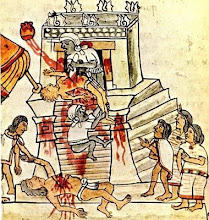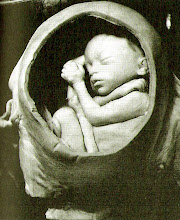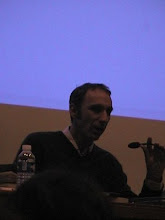The Heterological “Third Half-Time”
Some writers have described the importance of the Rugby's third half-time “troisième mi-temps” , there where the TV cameras arrive to transform intimacy in spectacle. We all know that half time means “to take a break” in every culture and in every kind of activity. Humans need to make pauses in almost all their activities. Sleep, for example, has been suggested by neurologists to be indispensable not only to renewing physical forces but also for the reconfiguration of our brain that makes a selection to save some memories and others not of the lived day. The same hypothesis has been applied to many phenomena as sportive games, religious trance or rave parties, where people live healing experiences. In this sense, holidays also represent an annual secular-sacred pause where sedentary life (work, family and general abstinence) is substituted by solar, economical, sexual, briefly, ludic activity excesses.
Whoever has participated in a team activity knows that half-times normally consists in a pause where coaches and players take a breath, drink water, talk and motivates each other, planning their next strategies. In theater or cinema production f or example, I have testified how actors get their concentration recovered by a drink accompanied wtih anphetamines alcaloids.
Some writers have described the importance of the Rugby's third half-time “troisième mi-temps” , there where the TV cameras arrive to transform intimacy in spectacle. We all know that half time means “to take a break” in every culture and in every kind of activity. Humans need to make pauses in almost all their activities. Sleep, for example, has been suggested by neurologists to be indispensable not only to renewing physical forces but also for the reconfiguration of our brain that makes a selection to save some memories and others not of the lived day. The same hypothesis has been applied to many phenomena as sportive games, religious trance or rave parties, where people live healing experiences. In this sense, holidays also represent an annual secular-sacred pause where sedentary life (work, family and general abstinence) is substituted by solar, economical, sexual, briefly, ludic activity excesses.
Whoever has participated in a team activity knows that half-times normally consists in a pause where coaches and players take a breath, drink water, talk and motivates each other, planning their next strategies. In theater or cinema production f or example, I have testified how actors get their concentration recovered by a drink accompanied wtih anphetamines alcaloids.
But what has been called the “troisième mi-temps” related to Rugby's practice is different as it represents the conclusion of that daily match and use to be linked with a musement's inversion of masculinity combat. Some sport media profit from this activity of Rugby players to scandalize their total team solidarity as it becomes a party time where excess dominates: drinking, dancing, laughing, kissing and sex. For Rugby players it seems to be part of their whole community practice, without major problems.
Suggested lecture
Raymond Abellio, « Géographie sacré du Rugby », Dans un âme et un corps, Gallimard, 1973. (Writer and Rugbyman)
Suggest Video
Suggested lecture
Raymond Abellio, « Géographie sacré du Rugby », Dans un âme et un corps, Gallimard, 1973. (Writer and Rugbyman)
Suggest Video
Sandbach Rugby Team, Generation Xcess, ITV2
URL: http://french-rugby-players.com/
Ritual Practice in Rugby.
One day, as Jean Prévost was having a drink at a PUB in New Zealand, he met an unknown man talking to him about the dream of many people in this country to become an “All Black”, that is to say, a national Rugbyman. Then they talked about the “Haka”, maori’s war song that this team uses to sing before every match. To see an example of this rite, please refer to the video bar above this blog.
Suggested lecture
Jean Prévost, « Avant la bataille », Plaisirs des sports, essais sur le corps humain, Gallimard, 1925. (Writer and Rugbyman)
Ludus pro Patria
« Rugby is a summary of the human adventure, a theater, a psychodrama of human behavior, from the most archaic to the most complex, from the most detestable to the noblest, from the most impulsive to the most rational.... The wardrobe/dressing room/vestiaire becomes the cave of the mutations.... It is a silent chapel where the walls shine with the vestments’ decorations that are the uniforms. ... It is the sacred place of ritual behavior inherited from the night of the ages ».
Suggested lecture
Daniel Herrero. « Un raccourci de l’aventure humaine ». Dictionnaire amoureux du Rugby. Plon, 2006. (Rugbyman, French Champion, 1987)
Solidarity in Rugby
« Rugby team consists of fifteen players, eight strong and active, two light and resourceful, four huge and fast, and the last one, model of phlegm and cold blood. This is also the ideal proportion in human groups ».
Suggested lecture
Jean Giraudoux. « Recreation virile ». Le sport, notes et maximes. Hachette, 1928. (Writer)
Commercial desacralisation in Rugby
« I consecrated all my life to Rugby that has its true roots in London... at 70 years of age Rugby remains in my life, in my heart, after my family. I continue with passion, but my passion is threatened by the evolution of the game. The brutal step to the professionalisation has changed everything. And I cannot believe it that has been produced by the own Englishmen that defended the amateurisme for a whole century. Rugby in France is still a sport of small cities like Mont-of-Marsan. I fear that its fundamental values as friendship, solidarity and team spirit might disappear. »
Suggested lecture
André Boniface, « Un Landais britannique », Nous étions si heureux, La Table Ronde, 2006.
Rugby as religion
Many people, fanatics and players ask to be buried with their official sportive equipment. This fact links Rugby game with the most profound of sacred human rituals, burials and homage to the dead.
Suggested lecture
Pierre Sansot, « Magie, pratiques incantatoires et croyances obscures », Le rugby est une fête, le tennis non plus. Payot et Rivages, 2005. (Anthropologist)
Identity in Rugby
« Rugby is a continent of emotions and references, an expressive song and thousands of songs to drink, a people that reencounters its own language wherever, Auckland or Narbonne, Cardiff or Brive. »
Suggested lecture
Marie Darrieussecq. « Un fantôme dans les tribunes ». L’Équipe Magazine. Samedi, 29 juillet, 2006. (Writer)
Bodily ethics in Rugby
No other game than Rugby in Western culture permits such bodily contact within the team. Corporal proximity and non aggressive touch becomes a main principle of the game. This practice evidences another form of tactile ethics, making disappear for a moment the canonical tabues of our culture in regards to corporal frontiers respect.
Suggested lecture
Anne Saouter. « Contact ». Être Rugby, jeux du masculin et du féminin. Maison des Sciences de l’Homme, Ministère de la Culture et de la Communication, coll. Éthnologie de la France. (Anthropologist)
Excitement and Cardiovascular Events during Rugby match watching
Bordeaux, 1965. semi-final Ang-Dax, three deads caused by cardiovascular events. The emotion... In Rugby spectacle as in Greek theater, there is no distance between players and spectators. The group sings and cries, exists…
The International Federation Football Association (FIFA) World Cup, held in Germany from June 9 to July 9, 2006, provided an opportunity for scientists to examine the relation between emotional stress and the incidence of cardiovascular events. The conclusion supports that viewing a stressful soccer match more than doubles the risk of an acute cardiovascular event, particularly in men with known coronary heart disease.
Suggested lectures
Michel Serres. « Le choeur antique sur le terrain. Le culte du ballon ovale ». Le Monde, 4 mars. 1979. (Philosopher)
Ute Wilbert-Lampen, et. al. Cardiovascular Events during World Cup Soccer. The New England Journal of Medicine. Boston, January 31, 2008. Vol. 358, Iss. 5, p. 475-83. URL: http://proquest.umi.com/pqdweb?did=1421641381
Team’s Solidarity efficacy narratives and ritual cohesion in Rugby
«There are not Rugby players, only Rugby teams ». Cult of the impersonality and of the distribution of tasks. The small ones infiltrate, the big ones advance, the agile ones escape. The athletes of Rugby form a solidary team nearer to the daily life tasks.
The relationship between perceived cohesion and collective efficacy in rugby teams has been studied by exploratory scientific studies. Self efficacy represents the degree to which one believes that one can successfully execute the behavior required to produce a specific outcome. These efficacy beliefs are thought to have important motivational implications in that they impact an individual's choice of activity, effort, and persistence. Self efficacy is hypothesized to positively influence performance. High levels of self-efficacy enhance performance and reduce the negative effects of defeat. Efficacy beliefs differentiate between successful and less successful athletes in situations of competitive stress. Collective efficacy could be indeed an extension of self-efficacy. Collective efficacy beliefs are hypothesized to have substantial implications for group effort, persistence, and performance, especially for tasks requiring interaction among group members. A strong sense of collective efficacy allows great teams to come from behind to win even when they are not playing their best. On the other hand, mediocre and inconsistent teams are often plagued by lower levels of efficacy and a degree of self doubt.
Suggested lectures
Antoine Blondin, « Le jeu d’une société plus qu’un jeu de société », Mes Petits Papiers. Chroniques et autres essais littéraires, La Table Ronde, 2006 .
Stephen A Kozub, Justine F McDonnell. Exploring the relationship between cohesion and collective efficacy in rugby teams. Journal of Sport Behavior. University of South Alabama, Jun 2000. Vol. 23, Iss. 2, p. 120-129 (10 pp.)
Visual Training in Rugby
Most team sports spend a considerable amount of time devoted to the physical and skill development of players. Fundamental to this process is the involvement of the visual system, and yet rarely do we hear of this quality being catered for within the strength and conditioning program.
The eye is an amazing piece of anatomical engineering. Each eye has 6 extraocular muscles that attach it to the eye socket. These muscles are designed to work individually or in combination to produce all the different movements of the eye, termed positions of gaze.Visual system is like any other motor system within the body: it can be trained and improved by "exercise." The visual system will respond to overload and progressive increases in demand just like the neuromuscular and cardiovascular systems will respond to training. Athletes may benefit from visual-fitness training by improving their eye-movement skills, focusing skills, peripheral visual awareness, and visualperceptual skills. The goal here is not to improve vision per se or strengthen the eye muscles but rather to enhance the speed, coordination, and endurance of eye movement. For example, during a game a player will need speed and accuracy of eye movement in superior gaze while fixating on a "high" ball as it moves in space, thus allowing him or her to react rapidly and precisely to get into a position to catch the ball.
Because this ability to focus is so limited, peripheral vision becomes increasingly important in sports. Our peripheral vision is designed to quickly detect motion so that the visual focus can be directed to other events. Size of an athlete's functional visual field is not fixed but varies according to a range of factors (e.g., the concurrent demands of activities performed in central vision; level of stress, fatigue, arousal). As a simple rule, the more complex and demanding the centrally performed task, or the more stressed the athlete, the narrower will be the functional visual field size, resulting in errors that coaches often describe as tunnel vision.
It has been said that we live in a Vision Culture. Nevertheless, the reality demonstrates that we do not know at all how to see. Even though our visual capacities for quick movements have been developed during the second half of the XX century by media technologies and videogames, I could say that we have lost our capacity to look carefully. Try yourself an experiment as you are in a museum or wherever. How long can you really “observe” the details in paintings and sculptures with carefully attention…, may be you will stand in front them longer than usually and you will not pass away quickly…but your mind will be "ailleurs"... I thought I used to see "properly" art works as a neurologist demostrated I was wrong and I am training to reeducate my visual habits. Coming from a more contemplative culture than Europeans, I think it is possible to do it. Mexicans in that sense are closer to Eastern cultures… as one travels through the country, one perceives this ethnical capacity for contemplation that surely has been a heritage from the most ancient immigrants coming from East that arrived to our country a long time ago… this is what I love to explain to foreign people who laughs about that traditional image of a Mexican sitting with his hat next to a cactus plant for hours and hours…. Visual capacities let us go down the trees and construct civilizations...
Coping strategies in Rugby
First class professional male rugby union players have pointed out that the most frequently coping strategies are increased concentration, blocking, positive reappraisal, and being focused on the task, being focusing on task and increasing effort the most effective coping strategies.
Suggested lecture
Adam R Nicholls, et. al. Stressors, Coping, and Coping Effectiveness Among Professional Rugby Union Players. The Sport Psychologist. Champaign:Sep 2006. Vol. 20, Iss. 3, p. 314-329.
URL:http://proquest.umi.com/pqdweb?did=1161961681&Fmt=2&clientId=15403&RQT=309&VName=PQD

